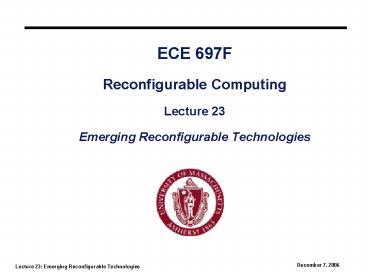ECE 697F Reconfigurable Computing Lecture 23 Emerging Reconfigurable Technologies PowerPoint PPT Presentation
1 / 18
Title: ECE 697F Reconfigurable Computing Lecture 23 Emerging Reconfigurable Technologies
1
ECE 697FReconfigurable ComputingLecture
23Emerging Reconfigurable Technologies
2
Overview
- Several emerging technologies may make an impact
- Carbon nanotubes
- Magnetoelectronic devices
- Technologies are in their infancy
- Another look at system-on-a-chip technology
- How to integrate an increasing number of on-chip
cores - Splitting hardware/software
- aSoC a new on chip communications architecture
for static applications
3
Consider Carbon Nanotubes
Slides courtesy DeHon
- Extensions of carbon molecules
- Grown as long straight tubes
- Flow used to align nanotubes in a specific
direction - Technology still in infancy
4
Bottom-Up Self-Assembly
- We cant make nano-circuits top-down
- Lithography cant get to the nano scale
- Make them bottom-up with chemical self-assembly
- Their own physical properties keep them in
regular order, much like crystals do when they
grow - Fluid flow self-assembly
- Crossbar generated in two passes
5
Possible Carbon Nanotube Devices
- Diode connection formed by making connection
between upper and lower nanotube - Nanotubes do not touch when forming a FET
- Top nanotube covered with oxide
- Effectively acts as a gate to current path
6
Diode Logic
- Arise directly from touching NW/NTs
- Passive logic
- Non-restoring
7
PMOS-like Restoring FET Logic
- Use FET connections to build restoring gates
- Static load
- Like NMOS (PMOS)
8
Programmed FET Arrays
9
Use to build Programmable OR-plane
- Addressing is a challenge since order of
addresses cant be predetermined - Nanotubes can be doped to form different
addresses - Some redundancy OK
- Diode logic formed at crosspoint
10
Simple Nanowire-Based PLA
NOR-NOR AND-OR PLA Logic
11
Defect Tolerance
All components (PLA, routing) interchangeable All
ows local programming around faults
12
Results FPGA2004
- Pair of 60-term OR planes roughly same size as
4-LUT - Special mapping and programming tools needed
- Fault tolerance a big issue
13
Magnetoelectronic Devices
- Program a cell by setting a directional magnetic
field - Programming current sets field
- Technique already heavily using in storage
devices - Flexible, reliable
- Advantages
- Non-volatile
- Low power consumption
Courtesy N. Carter
14
HHE device magnetoelectronic system
- Information written as magnetization states by
passing a write current through a current line - HIGH, and LOW output Hall voltage according to
direction of magntization. - Good remanance in the ferromagnet may lead to
hysteresis loop and hence memory - Easily integrated with rest of the CMOS circuit
Device structure
HHE integrated with CMOS logic
15
Magnetoelectronic Gates
- Use storage cell along with a minimum of external
transistors to create logic - External circuitry induces current which can
program cell - Variety of different functions can be implemented
16
Power Reducing Magnetoelectronic Gates
- Logic only evaluated if the output result will
change state - If change redetected then perform reset
- Otherwise, maintain old value.
17
Magnetoelectronic Look-up Tables
- SRAM storage cell used for high performance
- Initial value of SRAM cell stored in
magnetoelectronic cell - Cell is programmed following reset
SRAM cell
18
Summary Emerging Technologies
- Difficult to explore without experts in physics
and chemistry - Initial architecture ideas based on perceptions
of likely available technology - Daunting challenges involving CAD and power
reduction remain - Not likely to have much commercial application
for 10-15 years - Active area of research

